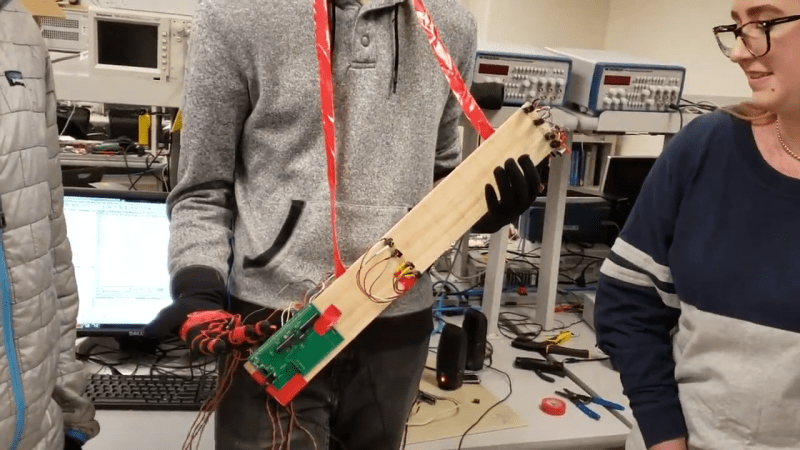If you play an instrument, you know how rewarding it is to watch and hear yourself reproduce your favorite songs and make new melodies. But you also know how steep the learning curve can be, how difficult it is to learn positions and notes while your body adjusts to the physical side. For stringed instruments, that means gaining muscle memory, growing fingertip calluses, and getting used to awkward arm positions.
For their final project in [Bruce Land]’s class on designing with microcontrollers, [Caitlin, Jackson, and Peter] decided to make a more accessible bass guitar. For starters, it can be placed flat on a table similar to a pedal steel guitar to get around those awkward arm positions. Instead of plucking or slapping the strings, the player wears a glove with a flex resistor on each finger, and plays the string by curling and uncurling their finger.
We think the team’s implementation of the left hand duties and fretboard is pretty clever. Each of the four strings has a break-beam detection circuit, and a single distance sensor decides where the finger is along the fretboard. Another great thing about this backpack-sized bass is that it never needs tuning. If you stay tuned, you can hear [Peter] play “Smoke On the Water” after the break.
There’s more than one way to make an air guitar — this one that does it with LIDAR.
















Good example of a project that would have benefited by working with a domain expert (i.e. bass player) before jumping too far into the implementation. The design prohibits any common right hand technique ever used by an actual bass player.
The domain expert is an airbase player, not a bass player. The “common right hand techniques” can be seen in lots of 90’s and 00’s boy-band music videos where you can see the “artist” can’t really play guitar
Bass? Organ perhaps.
Meh…I’ve gone down this road before. The problem with one-off novelty instruments is that you never learn how to play them. And if, somehow, you did learn, you would find the skill doesn’t transfer. And if you already knew how to play a real instrument, you’d be so frustrated at the clown instrument that you’d set it down and never pick it back up.
I don’t know of any examples of an actually-silent practice instrument…but generally if you’re actually gonna play it, even the Walmart guitar will do you better than this one, by leaps and bounds. And if you want to add DIY to your repertoire, nothing like repairing/upgrading a cheap/used instrument.
An electric or bass guitar is near silent without amplification.
Electric drum kits are similarly surprisingly quiet.
Electric keyboards and pianos are nearly silent.
If you’re looking for strictly completely silent, theramin or laser harps would be the most used instruments which are completely silent.
But totally agree about the ‘clown instrument’ comment – transferable skills are key, and it takes a lot of time to truly master an instrument. There’s lots of synth apps for tablets with novelty layouts, and aside from a few specific use cases, none get anywhere near the usability of a standard keyboard layout.
What are the 2 blue/gray instruments between the 2 people in the title photo?
I couldn’t find a sharp enough frame, but it looks like one of the words at the top of their front panel is Frequency. Judging by the controls, either a a precision frequency generator or a frequency counter.
An interesting idea, but not a practical instrument. There are some bass synths with much more practical interfaces, and the Seaboard keyboard with the rubber surface allows the player to generate real vibrato. A real bass requires a lot more technique than just getting the right pitch and plucking the string. Imogen Heaps “gloves” project can simulate a real bass quite well just with hand gestures. This soesn’t seem to have any of that. At the very least they need to be able to simulate the frets, so you can play in tune!
Had a look at the LIDAR link an that device is a much better version of a guitar, a Litar. It sounds like a Zither and has virtual frets in the control signal processing.
There is an instrument called an Harpejji which is really well executed and allows keyboard players to immediately transition to guitar-like strings. Since you do everything with fretting, and you don’t have to strum the same string, you can play with both hands as with a piano. There are videos on YouTube.
So, when they go up or down the scale, is it called an Harpeggio?
B^)